| Back |
Now that freesat is in operation, those of you who don’t want to pay for Sky have a reason to fit your first dish. There are plenty of channels, including high definition, and it really is free. Terrestrial aerials are ugly, especially the large ones needed in fringe areas like mine. Dishes are inherently more attractive, but more important, they don't have to be high up. All they need is a clear line of sight so they are more easily hidden away.
The only downside of satellite is 'rain fade'. This is reduction or loss of the signal when it rains very heavily, the sort of rain that sounds like hailstones on the roof. Sky has better data error correction than freesat so suffers less from it. This is one reason for fitting a dish that is larger than those used for Sky. It's hardly surprising we get rain fade. A satellite sends out about 200 watts from about 40 000 kilometres away. Not much energy compared with my local terrestrial transmitter which puts out 250 000 watts and is 50 km away.
Each satellite effectively sends out four sets of signals. There are two frequency bands and two polarisations of the waves. The four possibilities are high band/vertical polarisation (H/V), high band/horizontal polarisation (H/H), low/vertical (L/V) and low/horizontal (L/H). The signal from the satellite is collected by the dish and focussed on a low-noise block (LNB). This has a metal horn, called a 'feedhorn', that collects the signals, and circuits that detect and amplify it. The signals have a frequency in the range10.70 to 12.75 GHz, which is too high for a cable. Therefore the LNB converts it to an intermediate frequency (IF) of 950 to 2150 Mhz, and then sends it down a cable. Technically the full name of an LNB is 'low-noise block downconverter'.
The receiver decodes the signal and sends the programme information to the television. The receiver also powers the LNB and switches it to the correct channel (H/H, L/V etc.) for the television programme selected by you. The 13/18 volts signal switches to vertical/horizontal and the 0/22 kHz switches it to low/high band. It is the fact that the receiver has to communicate with the LNB that makes satellite connections different from terrestrial.
'Freesat' receivers
At present receivers are rather limited. There are plenty that allow you to view freesat programmes in normal or high definition. Once you start wanting to record programmes, things become more complicated. There are several receivers that allow you to record onto a hard disk drive either in the receiver or a box attached to it. However at the time of writing none have an optical DVD or BD drive onto which you can record. So you can only store a programme permanently if you have a separate recorder. Even then it might not be possible. On the HDMI page you will read that HDMI was adopted so that programme producers can control what you do with their property. For example you can't record high-quality digital programmes from an Onkyo AV receiver onto an optical disk. In any case to record high definition programmes you need a blu-ray drive because of the large amount of data. I get over this by having a satellite card in my computer and record onto a blu-ray writer on that.
Overall then a bit of a mess. What's needed is a twin tuner high definition freesat receiver with at least 500 Gbyte of hard disk, a blu-ray recorder and HDMI and component video outputs. There might be one before long, but don't hold your breath, and do start saving!
What system to set up?
This decision depends on how many televisions you want to connect to your dish.
One receiver and one LNB on the dish
If you only want to view satellite on one TV all you need is a dish and a single LNB, and a cable to the receiver box, or to a wall socket into which the receiver is plugged. The cable to the receiver is called an ‘endpoint connection’.
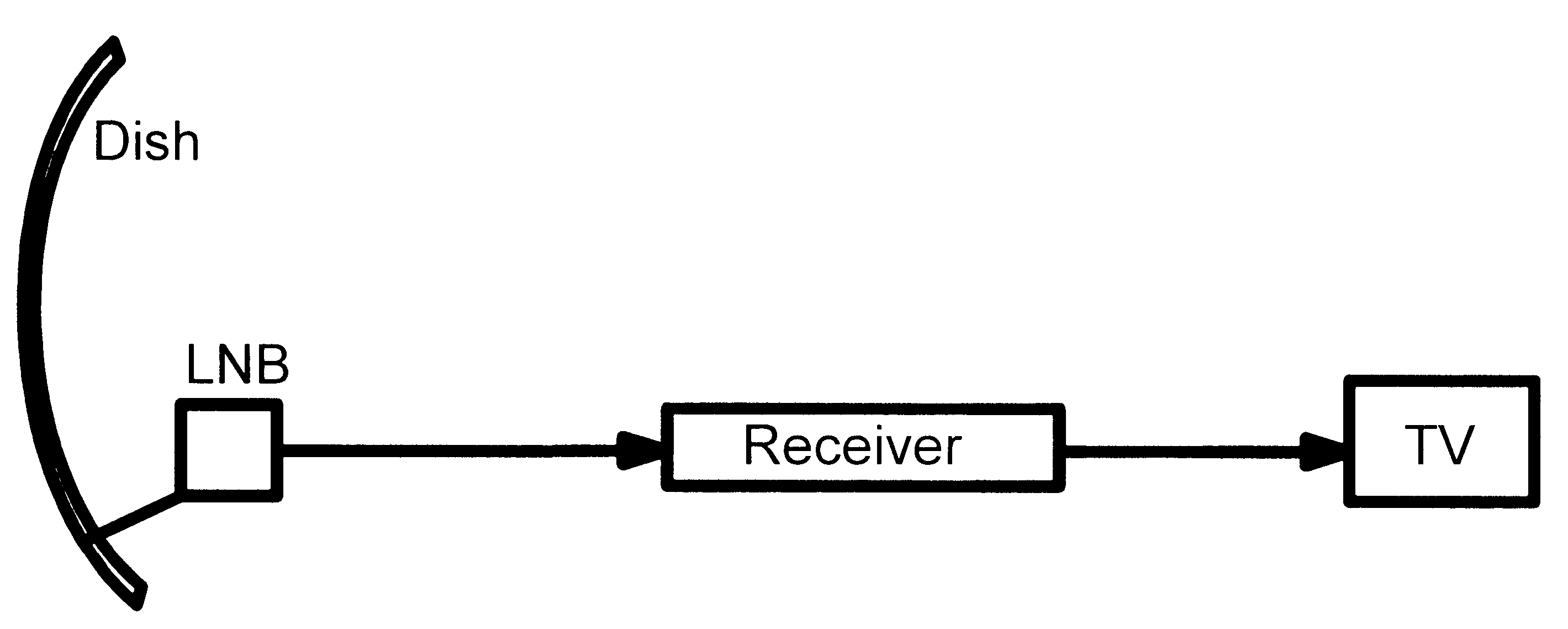
A complete system like this, with dish and bracket, LNB, receiver, cable and simple meter can be bought for as little as £70. An example of such a system is fitted to my workshop and is in the "Some of my installations" page. A low-cost system like this cannot be used for high definition TV. For that you will have to pay £70 upwards for the receiver, an increase of about £30 for the whole system. It's best not to fit a single LNB. Use a twin LNB, which is one with two outputs. You need two satellite sockets for freesat recorders as there are two input sockets on the receiver. One is to watch a programme and the other is to record a different programme, or to record two different programmes, at the same time. Each socket must have its own cable from the LNB. Some receivers allow you to loop a single cable back into the second socket. This allows you to record one programme whilst watching another, but both must be on the same band and polarity.
More than one receiver and television: simple systemThe simplest solution is to have a quad universal LNB. This will have four F-connector sockets instead of one. Each has an endpoint connection to one receiver socket. If each wall plate has two sockets each fed by its own cable, you can record one programme whilst watching another.
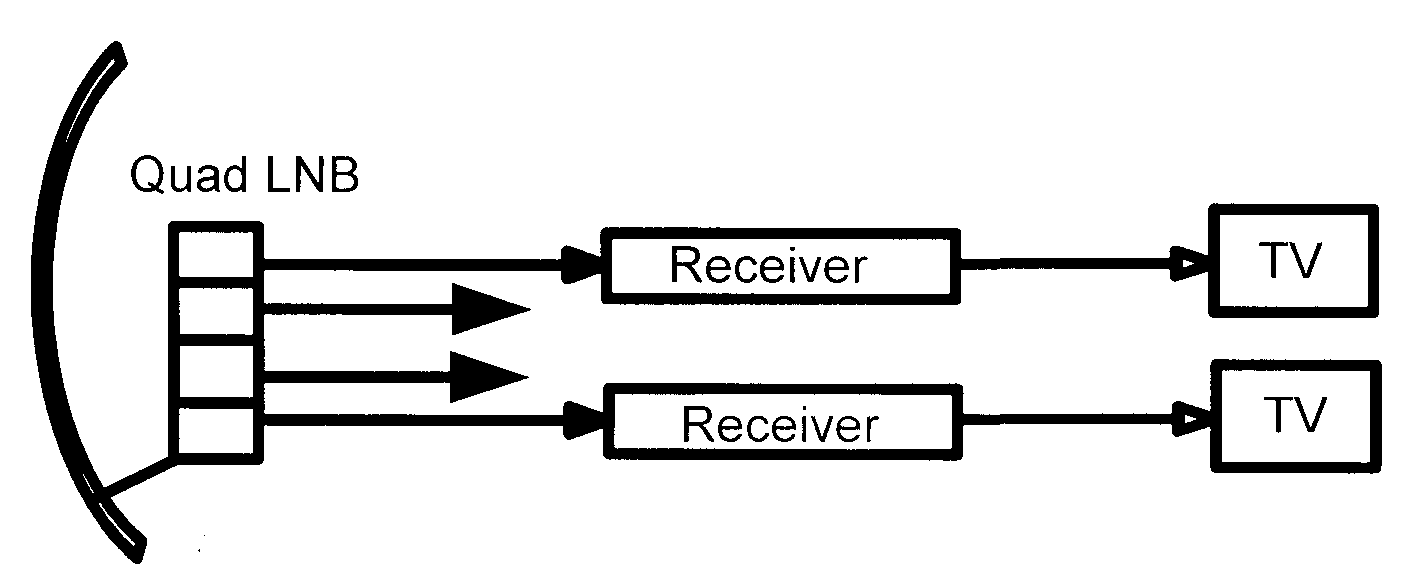
More than one receiver and television: more complex system
You need a quatro LNB. This has four outputs like a quad. However each is fixed to one of the band/polarisation combinations. Four cables, called ‘polarity trunks’, carry these four signals to a ‘multiswitch’. This combines the signals so that all four are available at each of several outputs. There is one output for each endpoint connection to a receiver. Each receiver can then choose which signal it uses based on the programme channel selected by the user. Each endpoint output is like a separate universal LNB. Multiswitches might have four, eight, sixteen or more outputs. When deciding how many you need, remember to allow for two sockets in rooms where you will use a recorder.
The multiswitch sends power to the LNB. It can also accept, and mix in, a signal from a terrestrial aerial for television or DAB radio, or from a masthead amplifier including ones that mix signals from several aerials. Each endpoint cable will then carry both satellite and terrestrial signals to one wall socket. To view channels on freeview you connect the output F-socket on the freesat receiver, or a wall F-socket, to the co-axial input on your freeview box or television.
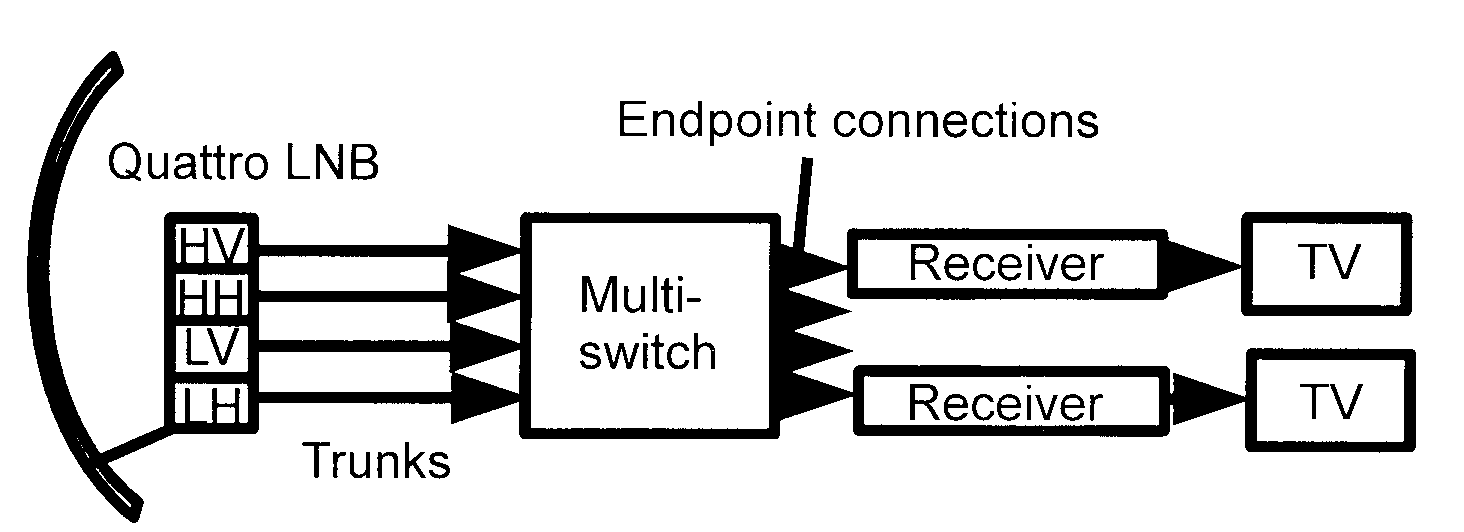
Most, if not all, multiswitches power all four LNB inputs, which is necessary if you use inline amplifiers near the dish in the trunks, which also have to be powered. There's at least one make of switch which can provide 13 V on the vertical inputs and 22 kHz on the high-band inputs, enabling a standard quad LNB to be used.
You can fit more than one LNB to a dish, arranged on a bar so each is at the focal point for one satellite. Narrow LNBs are available to make this easier. Alternatively you can buy an assembly with two LNBs built in, where the angle between them is correct for a particular pair of satellites. You will need a multiswitch with multiples of four inputs for this, plus one if you including terrestrial - nine for two LNBs, thirteen for three and so on. You can have more than one dish, which can be fed into a nine or thirteen input multiswitch. Remember that this will mean eight, twelve or sixteen cables coming from the dish(es) into the house. The last option is to buy a steerable dish which can be moved to any visible satellite. All of the satellites lie on one arc in the sky. If you are distributing the signal from a steerable dish, all endpoints will have to use the satellite currently aimed at.
Unused outlets, and cables not plugged in to a receiver, should have a dummy load terminator screwed in. This absorbs the signal and stops it being reflected back and corrupting the other signals. If you are installing a large system all endpoint connections should have a common earth for safety. Where one system goes to several dwellings, by law you must use an earth bonding strip, which should be connected to an earth point by a 4 square mm cable.
This is one of my head-end boards installed in a loft. This accepts the four trunks from a quatro LNB into the F sockets on the bottom of the multiswitch and could take a set of terrestrial aerials into the fifth socket on the left side. It provides endpoint connection sockets for eight satellite boxes, freeview boxes, analogue TVs, and DAB or VHF FM radios. The earth bonding strip is at the bottom of the board. Note that each of the four currently unused outlets on it has a terminator, an example of which is below. Such a multiswitch is called a 'terminated multiswitch'. It is mains powered and can power other devices such as amplifiers and cascade switches described later.
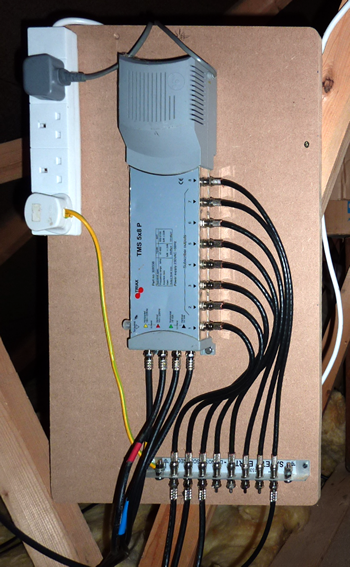
Terminator
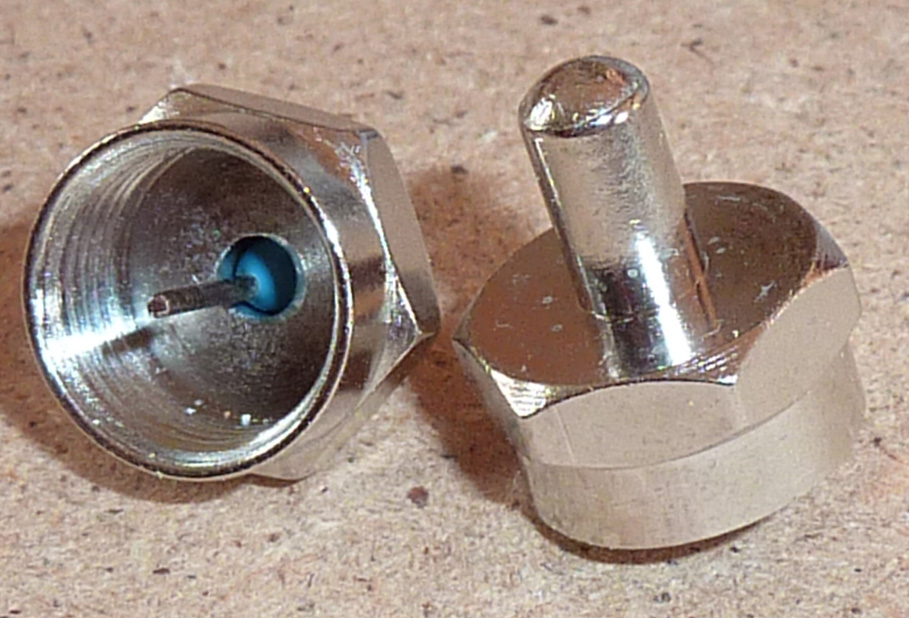
Cascade multiswitches
For very large systems, for example where the house is large or long, cascade multiswitches are used. You only have to route four trunk cables to the distant points, rather than one or two cables for each room. Cascade switches have four trunk outputs, or five if the UHF is combined, to go on to the next cascade multiswitch, or to the final terminated multiswitch.
This is a cascade multiswitch. Notice that it has five inputs on the top for the four polarities from the quatro lnb and a terrestrial aerial. There are five outputs on the bottom to carry the signals in trunk cables to the terminated multiswitch shown above. This model has eight outputs to endpoints, but it can be bought with up to thirty-two. This switch is not mains powered, as it gets its power from the terminated switch through the trunks.
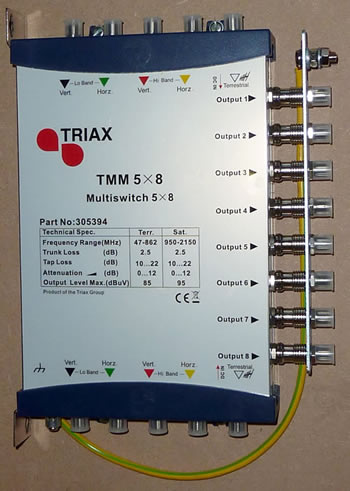
This is the same cascade switch installed in a loft. The trunk cables are colour-coded with heat shrink sleeving so they don't get mixed up. This model has a built-in earth bonding strip. It also amplifies the signals before sending them on to the terminated switch. The amount of amplification can be adjusted with small controls on the bottom of the device. Note the space on the board for future expansion.
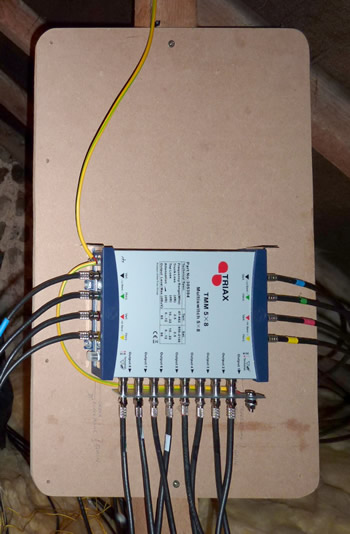
Signal strength
The larger the dish the bigger the signal. Doubling the diameter of the dish quadruples its area and signal. If planning to use multiple LNBs, or if you want to access a variety of satellites using a steering mechanism, it is best to go for a larger dish than the 65cm ones often used. This will also give a higher signal to noise ratio, known in the satellite field as carrier to noise ratio (CNR). This directly affects the bit error rate, which in turn determines whether you have a picture or not. Provided the dish is smaller than one metre there should be no problem with the planners, and you can buy transparent ones. If you have total cable runs from LNB to wallplates that are longer than 30 metres or so you might need an inline amplifier, just as you would for terrestrial. However, provided the CNR starts off high at the LNB, the signal can drop very low before the sensitive receivers have difficulty. The LNB generates noise so you should buy one that is as quiet as possible, 0.2 or 0.1 dB is a good figure. Each device, such a multiswitch, adds its own noise as well.
Installing a dishDishes are normally fitted on a wall bracket, though sometimes on a chimney. I've got mine fitted to the 2" terrestrial aerial mast between the two wall brackets. Check that the mounting is vertical using a spirit level. Don't rely on your wall being correct. Buy a satellite signal meter, which should cost no more than a few pounds. You will first need to choose the satellite you are intending to use from LyngSat. It will probably be Astra 2A / 2B / 2D & Eurobird 1.There are three settings for the dish: elevation (vertical position), azimuth (horizontal position) and LNB rotation angle. You will need to find out the values of these for where the dish is to be installed. You can get them from www.satsig.net after entering the satellite name and pointing to your position on the map, or entering your map reference.
Alternatively, if you have smart phone, there are several apps that show you visually where a satellite is in the sky. You can easily check line-of-sight and get the dish set in roughly the right direction. One is called DishPointer and costs about £12. Well worth it!
Connect the LNB to the meter, and the meter to the receiver, using temporary F cables. Set the elevation approximately using the scales marked on the dish brackets. Then use a compass, as described above for aerials, to get a rough azimuth position, or just use a neighbour's aerial as a guide. Set the LNB rotation angle then fiddle with the azimuth to get the best signal on the meter. Then fiddle with the elevation to get best signal. Finally make small changes to the rotation.
For greater accuracy hire or buy a Satlook or Horizon meter. There is no doubt that this will enable you to do a more accurate job. If you are using one of these you need to know that 13 volts give vertical polarisation and 22 kHz gives the high band. So the combination for most freesat channels is 0 kHz and either 13 or 18 volts. I use a Satlook micro. A lead with a push-on F plug on each end is a good idea. When setting up and testing it avoids endlessly screwing and unscrewing the normal F plugs.
The two key measurements for best reception are carrier-to-noise ratio (CNR) and bit error rate (BER). The CNR is measured in decibels (dB), which is explained in the glossary. You should get between 8 and 15 dB. BER is given as the ratio of bad bits to good bits. A good signal will give 1 bad bit to 10 000 good ones. To confuse us all, this is shown as 1 / 10 000 in scientific type numbers, so is 1 x 10 to the power -4 or 1 x E-4. A BER of 1 x E-3 is flaky in rainy weather, 1 x E-4 is solid and 1 x E-5 or better is excellent. 3 x E-4 is better than 6 x E-4, because the divisor in the ratio (good bits) is smaller.
The strength of the signal affects CNR but offset (rotation angle) strongly affects the BER. You cannot measure CNR or BER with a simple meter. Once you have got the strongest possible signal by adjusting azimuth and elevation, you then slacken the LNB slightly and turn it by a small amount. Take your hand away and wait for the meter to give you the new BER. Continue to adjust the position until you have got the best BER.
Frequency ------------------------------>
This diagram shows why offset affects BER. The red shapes are the horizontally polarised frequency channels. Blues are the vertical ones. You see that the reds do not overlap each other. Nor do the blues. However reds overlap blues. Provided the LNB is set to the correct angle it will be perfectly aligned with one polarisation and will reject the other completely. If slightly out, some of the other polarisation will leak in and corrupt the signal. This will make the BER worse. A satellite is set up like this to double the amount of data it can send in a given range of frequencies.
Your meter might also have a constellation diagram display. It looks like one of these:
If you want to find out what it means, take a deep breath and drink a large cup of coffee. Then read the entry in the glossary. Then look it up in Wikipedia, and then give up. All you need to know is that a large cloud of dots filling each quadrant is bad (left-hand diagram), showing lots of various errors in the data, and a small cloud well out from the middle is good (right-hand).
If you are using a quatro LNB you will need to choose one or two of the sockets to test. On most quatros you can supply power to any of the output F sockets and all four outputs will be active. Choose the polarisation/band combinations that have the channels that you will be using. For freesat these will be the horizontal and vertical polarisations on low band, which are usually coloured Green and Blue/Black on the multiswitch. Connect your meter to one of those F sockets and align your dish. After that, check that there is a good signal on the other polarisation/frequency combinations. If using a Satlook you can connect to two F sockets at the same time, but you can only read CNR and BER from one. The other just gives signal strength.
Run a cable from each of the F-connectors on the LNB into the house as described on the Aerials and dishes page. Use only the best quality co-axial cable such as Raydex/Belden/Webro CT100, or foam-filled WF100 where sharpish bends are likely. As a rule of thumb don't bend a cable tighter than the radius of a coffee cup. Cheap cable can cause high losses and signal degradation and can cost more in the end when you decide that you have to replace it. For information about cable types, and a great deal of other useful and funny information, see Wright's Aerials. Use flexible boots or tape, and perhaps silicone grease, to protect the outdoors F plugs and sockets from water and to seal any unused F-connector sockets on the LNB. Alternatively you can get crimp-on F-connectors that are waterproof so need no boot, tape or grease. They are more expensive but well worth it.
Job done!
From then on you can enhance your satellite setup in a variety of ways. You might add a second LNB or motorise your dish to get a bigger range of satellites. Why not watch Fenerbahce TV on Turksat 1C, or the Dutch Maharishi Open University on Hotbirds 2/6/7A/8? You might extend your cabling so that there is a socket in every room, provided you have enough sockets on your multiswitch.
| Back |
(C) Peter Scott 2009
Last edit 17 April 2017